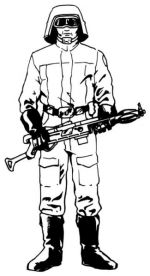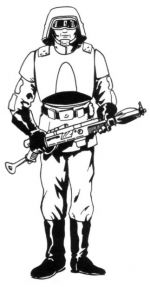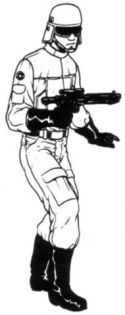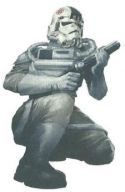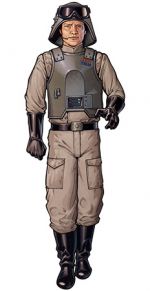Difference between revisions of "Imperial Army"
| Line 9: | Line 9: | ||
==Formations== | ==Formations== | ||
The strategic organization of Imperial Army units are as follows: | The strategic organization of Imperial Army units are as follows: | ||
| − | + | ===Army=== | |
| − | + | '''Commander:''' General<br> | |
| + | An army is composed of four corps and capable of capturing and holding key planetary systems. Though most individual armies' generals answer directly to Imperial Army Command, multiple armies in a given sector are frequently put under the command of a sector's Moff. | ||
| + | ===Corps=== | ||
| + | '''Commander:''' Major General<br> | ||
| + | A corps is designed to capture entire planets. As such, their command structures inevitably see oversight from Imperial Intelligence and other advisors. A corps HQ is always constructed, and consists of at least one fully automated manufacturing facility. | ||
| + | * '''Line Corps:''' Three ''line battlegroups'' and one ''assault battlegroup''. | ||
| + | * '''Atrisian Corps:''' Named for an ancient order of warriors, this configuration includes two ''assault battlegroups'', one ''line battlegroup'', and one ''armor battlegroup''. | ||
| + | * '''Armor Corps:''' Intended for heavy offense, an armor corps is three ''armor battlegroups'' and one ''mobile battlegroup''. | ||
| + | * '''Mobile Corps:''' Designed for quick engagement, this is made up of three ''mobile battlegroups'', and one ''armor battlegroup''. | ||
===Battlegroup=== | ===Battlegroup=== | ||
| − | + | '''Commander:''' Colonel<br> | |
| + | Usually intended to capture continents, battlegroups are composed of four regiments. | ||
| + | * '''Line Battlegroup:''' Three ''line regiments'' and one ''assault regiment''. | ||
| + | * '''Assault Battlegroup:''' Also referred to as ''reinforced battlegroups'', these are composed of two ''line regiments'', one ''assault regiment'', and one ''armor regiment''. | ||
| + | * '''Armor Battlegroup:''' Intended to be trained on concentrated knots of resistance, this is made up of four ''armor regiments''. | ||
| + | * '''Mobile Battlegroup:''' Three ''repulsorlift regiments'' and one ''line regiment'' providing swiftly mobilized and solidly supported infantry. | ||
===Regiment=== | ===Regiment=== | ||
'''Commander:''' Lieutenant Colonel<br> | '''Commander:''' Lieutenant Colonel<br> | ||
Revision as of 09:57, 13 February 2017
Contents
Operations
The Imperial Army exists to ensure the supremacy of the Empire's military on the surface of planets. Typical objectives include:
- Engagement with enemy infantry and armored vehicles.
- Destruction of an enemy holding of some kind.
- Creating opportunities for the deployment of more specialized units, including IA Special Missions or stormtrooper units.
- Establishing and maintaining control of specific resources
- Defense of supply line integrity
- Defend emplacement or other site
Formations
The strategic organization of Imperial Army units are as follows:
Army
Commander: General
An army is composed of four corps and capable of capturing and holding key planetary systems. Though most individual armies' generals answer directly to Imperial Army Command, multiple armies in a given sector are frequently put under the command of a sector's Moff.
Corps
Commander: Major General
A corps is designed to capture entire planets. As such, their command structures inevitably see oversight from Imperial Intelligence and other advisors. A corps HQ is always constructed, and consists of at least one fully automated manufacturing facility.
- Line Corps: Three line battlegroups and one assault battlegroup.
- Atrisian Corps: Named for an ancient order of warriors, this configuration includes two assault battlegroups, one line battlegroup, and one armor battlegroup.
- Armor Corps: Intended for heavy offense, an armor corps is three armor battlegroups and one mobile battlegroup.
- Mobile Corps: Designed for quick engagement, this is made up of three mobile battlegroups, and one armor battlegroup.
Battlegroup
Commander: Colonel
Usually intended to capture continents, battlegroups are composed of four regiments.
- Line Battlegroup: Three line regiments and one assault regiment.
- Assault Battlegroup: Also referred to as reinforced battlegroups, these are composed of two line regiments, one assault regiment, and one armor regiment.
- Armor Battlegroup: Intended to be trained on concentrated knots of resistance, this is made up of four armor regiments.
- Mobile Battlegroup: Three repulsorlift regiments and one line regiment providing swiftly mobilized and solidly supported infantry.
Regiment
Commander: Lieutenant Colonel
Regiments are considered capable of capturing large territorial regions, composed as they are of four battalions. Regiments require extensive support and resupply, and almost all are deployed with prefab headquarters, including a manufacturing workshop to produce spare parts for walkers and other gear needs.
- Line Regiment: Two line battalions, one assault battalion, and a repulsorlift battalion form the standard complement considered vital for the long-term occupation of a planetary region.
- Assault Regiment: Devastating in their destructive power, assault regiments are made up of two assault battalions, one line battalion, and one armor battalion.
- Repulsorlift Regiment: Fast-acting and responsive, consisting of three repulsorlift battalions and one armor battalion.
- Artillery Regiment: Used to over see the siege of significant targets, and made up of three artillery battalions and one assault battalion. These deployments are frequently backed up by a single scout company.
- Armor Regiment: Two armor battalions combined with two repulsorlift battalions, used to inflict grievous damage to a region.
Battalion
Commander: Major
Composed of four companies, battalions are considered capable of facing down significant military resistance in the taking of major urban centers or large territories. This is the scale of deployment usually considered necessary to suppress an uncontrolled planet in active rebellion.
- Line Battalion: Standard battalion configurations are made up of three line companies and one assault company.
- Assault Battalion: Used to storm fortifications and breach defensive walls, and composed of two assault companies, one repulsorlift company, and one line company.
- Repulsorlift Battalion: Made up of three repulsorlift companies and one scout company.
- Artillery Battalion: Three artillery companies, with a heavy weapons company deployed to protect the battery emplacements.
- Armor Battalion: Devastating deployments of heavy armor, made up of one breakthrough armor company, two attack armor companies, and one repulsorlift company.
- Special Missions Battalion: Four special missions companies. This is the largest configuration of special missions forces in the Imperial Army.
Company
Commander: Captain
Composed of four platoons, a company is capable of taking a city. They are large enough to include the services of support personnel (including logistics, medical, and technical support troops). A company also includes a large number of military-issue droids to resupply troops in the field and perform administrative functions at command posts.
- Line Company: Generally composed of three line platoons and one heavy weapons repulsorlift platoon.
- Assault Company: Also called heavy weapons companies, these are typically composed of two line platoons and two assault platoons, generally acting as the multipurpose surface unit.
- Scout Company: A single operating company consisting of four scout platoons and their vehicles.
- Repulsorlift Company: Two repulsorlift platoons are used to transport and then provide covering fire for two line platoons.
- Drop Company: Skilled survivalists usually made up of two scout platoons and two assault platoons, these companies are frequently dropped behind enemy lines, scouting out landing zones and resupply points used later during full-scale invasions.
- Artillery Company; or Battery: A battery consists of four artillery platoons.
- Armor Company (Attack Armor): Made up of three armor platoons and a heavy weapons platoon, deployed for their battlefield versatility.
- Armor Company (Breakthrough Armor): Breakthrough armor companies always consist of four armor platoons, acting as devastating sources of destruction.
- Special Missions Company: Operating as expeditionary forces, combining three special missions platoons and one scout platoon, allowing them to quickly identify and accomplish mission objectives.
Platoon
Commander: Lieutenant
Composed of four squads, the platoon is considered capable of capturing and pacifying a small settlement, or a notable district in an urban area.
- Line Platoon: A basic infantry platoon, composed of four line squads.
- Assault Platoon: A blended configuration of two line squads and two heavy weapons squads. It may be augmented with armored vehicles.
- Artillery Platoon: A collection of four artillery pieces or eight artillery-equipped light vehicles, and their crews, all intended to assault distant targets.
- Repulsorlift Platoon: Made up of four repulsorlift squads, used for harassment skirmishes to disrupt enemy lines.
- Heavy Weapons Repulsorlift Platoon: Four heavy repulsorlift squads combined to create a signficiant infantry-breaking force.
- Armor Platoon: Consisting of either four heavy walkers or eight repulsorlift tanks, accompanied by two heavy transport vehicles for repair and resupply.
- Special Missions Platoon: These platoons are often built on an ad hoc basis, constructed around the specific needs of a given mission or deployment. A typical such complement might include two sharpshooter squads, an engineering squad, and a heavy weapons squad, for example.
- Scout Platoon: Made up of two scout squads and two line squads, intended for reconnaissance missions or for the delivery of messages in the case of comms malfunction or jamming.
Squad
Commander: Sergeant
The smallest unit of Imperial Army forces, composed of nine troopers: eight IA troopers, and a sergeant as the acting commander, largely considered capable of taking and securing a building. They are frequently divided into two four-man "fire teams". Each squad frequently has a specific specialty, with equipment and training that reflects that. The typical formations are:
- Line Squad: The basic Imperial infantry unit, intended for deployment in a wide variety of situations, often as support or defense for other resources.
- Heavy Weapons Squad: As the Line Squad, but equipped with light repeating blasters to provide front-line firepower.
- Sharpshooter Squad: Often made up of Special Missions troopers, and armed with sniper rifles and deployed in overlapping fields of fire in the terrain.
- Engineering Squad: Also frequently made up of Special Missions troopers, and composed of demolitions and repair experts with extensive tech training.
- Repulsorlift Squad: A unit made up of drivers, gunners and mechanics, usually divided between two light repulsorlift transports.
- Heavy Weapons Repulsorlift Squad: Also assigned to the operation of two repulsorlift transports, these vehicles are packed with repeating blaster cannons or grenade launchers.
- Scout Squad: The basic recon squad consists of two "lances" - each a group of four troopers equipped with speeder bikes or AT-RTs.
